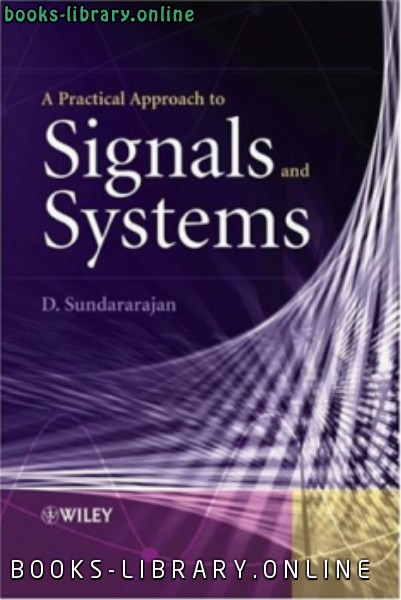📘 قراءة كتاب Signals and systems أونلاين


تحليل الإشارات والنظم
للمؤلف : d sundararajan
تحليل الإشارات والنظم
للمؤلف : d sundararajan
تأليف:
عبدالرحمن عليان موسى العليان
A PRACTICAL APPROACH
TO SIGNALS AND SYSTEMS
D. Sundararajan
John Wiley & Sons (Asia) Pte Ltd
Copyright © 2008 John Wiley & Sons (Asia) Pte Ltd, 2 Clementi Loop, # 02-01,
Singapore 129809
Visit our Home Page on www.wiley.com
All Rights Reserved. No part of this publication may be reproduced, stored in a retrieval system or transmitted in any
form or by any means, electronic, mechanical, photocopying, recording, scanning, or otherwise, except as expressly
permitted by law, without either the prior written permission of the Publisher, or authorization through payment of
the appropriate photocopy fee to the Copyright Clearance Center. Requests for permission should be addressed to
the Publisher, John Wiley & Sons (Asia) Pte Ltd, 2 Clementi Loop, #02-01, Singapore 129809, tel: 65-64632400,
fax: 65-64646912, email: enquiry@wiley.com.sg
Designations used by companies to distinguish their products are often claimed as trademarks. All brand names and
product names used in this book are trade names, service marks, trademarks or registered trademarks of their
respective owners. The Publisher is not associated with any product or vendor mentioned in this book. All
trademarks referred to in the text of this publication are the property of their respective owners.
This publication is designed to provide accurate and authoritative information in regard to the subject matter
covered. It is sold on the understanding that the Publisher is not engaged in rendering professional services. If
professional advice or other expert assistance is required, the services of a competent professional should be sought.
Other Wiley Editorial Offices
John Wiley & Sons, Ltd, The Atrium, Southern Gate, Chichester, West Sussex, PO19 8SQ, UK
John Wiley & Sons Inc., 111 River Street, Hoboken, NJ 07030, USA
Jossey-Bass, 989 Market Street, San Francisco, CA 94103-1741, USA
Wiley-VCH Verlag GmbH, Boschstr. 12, D-69469 Weinheim, Germany
John Wiley & Sons Australia Ltd, 42 McDougall Street, Milton, Queensland 4064, Australia
John Wiley & Sons Canada Ltd, 6045 Freemont Blvd, Mississauga, ONT, L5R 4J3, Canada
Wiley also publishes its books in a variety of electronic formats. Some content that appears in print may not be
available in electronic books.
Library of Congress Cataloging-in-Publication Data
Sundararajan, D.
Practical approach to signals and systems / D. Sundararajan.
p. cm.
Includes bibliographical references and index.
ISBN 978-0-470-82353-8 (cloth)
1. Signal theory (Telecommunication) 2. Signal processing. 3. System analysis. I. Title.
TKTK5102.9.S796 2008
621.382’23–dc22
2008012023
ISBN 978-0-470-82353-8 (HB)
Typeset in 11/13pt Times by Thomson Digital, Noida, India.
Printed and bound in Singapore by Markono Print Media Pte Ltd, Singapore.
This book is printed on acid-free paper responsibly manufactured from sustainable forestry in which at least two
trees are planted for each one used for paper production.
Contents
Preface xiii
Abbreviations xv
1 Introduction 1
1.1 The Organization of this Book 1
2 Discrete Signals 5
2.1 Classification of Signals 5
2.1.1 Continuous, Discrete and Digital Signals 5
2.1.2 Periodic and Aperiodic Signals 7
2.1.3 Energy and Power Signals 7
2.1.4 Even- and Odd-symmetric Signals 8
2.1.5 Causal and Noncausal Signals 10
2.1.6 Deterministic and Random Signals 10
2.2 Basic Signals 11
2.2.1 Unit-impulse Signal 11
2.2.2 Unit-step Signal 12
2.2.3 Unit-ramp Signal 13
2.2.4 Sinusoids and Exponentials 13
2.3 Signal Operations 20
2.3.1 Time Shifting 21
2.3.2 Time Reversal 21
2.3.3 Time Scaling 22
2.4 Summary 23
Further Reading 23
Exercises 23
3 Continuous Signals 29
3.1 Classification of Signals 29
3.1.1 Continuous Signals 29
3.1.2 Periodic and Aperiodic Signals 30
3.1.3 Energy and Power Signals 31
vi Contents
3.1.4 Even- and Odd-symmetric Signals 31
3.1.5 Causal and Noncausal Signals 33
3.2 Basic Signals 33
3.2.1 Unit-step Signal 33
3.2.2 Unit-impulse Signal 34
3.2.3 Unit-ramp Signal 42
3.2.4 Sinusoids 43
3.3 Signal Operations 45
3.3.1 Time Shifting 45
3.3.2 Time Reversal 46
3.3.3 Time Scaling 47
3.4 Summary 48
Further Reading 48
Exercises 48
4 Time-domain Analysis of Discrete Systems 53
4.1 Difference Equation Model 53
4.1.1 System Response 55
4.1.2 Impulse Response 58
4.1.3 Characterization of Systems by their Responses to Impulse
and Unit-step Signals 60
4.2 Classification of Systems 61
4.2.1 Linear and Nonlinear Systems 61
4.2.2 Time-invariant and Time-varying Systems 62
4.2.3 Causal and Noncausal Systems 63
4.2.4 Instantaneous and Dynamic Systems 64
4.2.5 Inverse Systems 64
4.2.6 Continuous and Discrete Systems 64
4.3 Convolution–Summation Model 64
4.3.1 Properties of Convolution–Summation 67
4.3.2 The Difference Equation and Convolution–Summation 68
4.3.3 Response to Complex Exponential Input 69
4.4 System Stability 71
4.5 Realization of Discrete Systems 72
4.5.1 Decomposition of Higher-order Systems 73
4.5.2 Feedback Systems 74
4.6 Summary 74
Further Reading 75
Exercises 75
Contents vii
5 Time-domain Analysis of Continuous Systems 79
5.1 Classification of Systems 80
5.1.1 Linear and Nonlinear Systems 80
5.1.2 Time-invariant and Time-varying Systems 81
5.1.3 Causal and Noncausal Systems 82
5.1.4 Instantaneous and Dynamic Systems 83
5.1.5 Lumped-parameter and Distributed-parameter Systems 83
5.1.6 Inverse Systems 83
5.2 Differential Equation Model 83
5.3 Convolution-integral Model 85
5.3.1 Properties of the Convolution-integral 87
5.4 System Response 88
5.4.1 Impulse Response 88
5.4.2 Response to Unit-step Input 89
5.4.3 Characterization of Systems by their Responses to Impulse
and Unit-step Signals 91
5.4.4 Response to Complex Exponential Input 92
5.5 System Stability 93
5.6 Realization of Continuous Systems 94
5.6.1 Decomposition of Higher-order Systems 94
5.6.2 Feedback Systems 95
5.7 Summary 96
Further Reading 97
Exercises 97
6 The Discrete Fourier Transform 101
6.1 The Time-domain and the Frequency-domain 101
6.2 Fourier Analysis 102
6.2.1 Versions of Fourier Analysis 104
6.3 The Discrete Fourier Transform 104
6.3.1 The Approximation of Arbitrary Waveforms with a Finite
Number of Samples 104
6.3.2 The DFT and the IDFT 105
6.3.3 DFT of Some Basic Signals 107
6.4 Properties of the Discrete Fourier Transform 110
6.4.1 Linearity 110
6.4.2 Periodicity 110
6.4.3 Circular Shift of a Sequence 110
6.4.4 Circular Shift of a Spectrum 111
6.4.5 Symmetry 111
6.4.6 Circular Convolution of Time-domain Sequences 112
viii Contents
6.4.7 Circular Convolution of Frequency-domain Sequences 113
6.4.8 Parseval’s Theorem 114
6.5 Applications of the Discrete Fourier Transform 114
6.5.1 Computation of the Linear Convolution Using the DFT 114
6.5.2 Interpolation and Decimation 115
6.6 Summary 119
Further Reading 119
Exercises 119
7 Fourier Series 123
7.1 Fourier Series 123
7.1.1 FS as the Limiting Case of the DFT 123
7.1.2 The Compact Trigonometric Form of the FS 125
7.1.3 The Trigonometric Form of the FS 126
7.1.4 Periodicity of the FS 126
7.1.5 Existence of the FS 126
7.1.6 Gibbs Phenomenon 130
7.2 Properties of the Fourier Series 132
7.2.1 Linearity 133
7.2.2 Symmetry 133
7.2.3 Time Shifting 135
7.2.4 Frequency Shifting 135
7.2.5 Convolution in the Time-domain 136
7.2.6 Convolution in the Frequency-domain 137
7.2.7 Duality 138
7.2.8 Time Scaling 138
7.2.9 Time Differentiation 139
7.2.10 Time Integration 140
7.2.11 Parseval’s Theorem 140
7.3 Approximation of the Fourier Series 141
7.3.1 Aliasing Effect 142
7.4 Applications of the Fourier Series 144
7.5 Summary 145
Further Reading 145
Exercises 145
8 The Discrete-time Fourier Transform 151
8.1 The Discrete-time Fourier Transform 151
8.1.1 The DTFT as the Limiting Case of the DFT 151
8.1.2 The Dual Relationship Between the DTFT and the FS 156
8.1.3 The DTFT of a Discrete Periodic Signal 158
8.1.4 Determination of the DFT from the DTFT 158
Signals and systems
signals and systems pdf
signals and systems شرح
signals and systems oppenheim pdf
signals and systems course
signals and systems mit
signals and systems mit video lectures
signals and systems book
signals and systems exams
سنة النشر : 2008م / 1429هـ .
حجم الكتاب عند التحميل : 2.6 ميجا بايت .
نوع الكتاب : pdf.
عداد القراءة:
اذا اعجبك الكتاب فضلاً اضغط على أعجبني و يمكنك تحميله من هنا:

شكرًا لمساهمتكم
شكراً لمساهمتكم معنا في الإرتقاء بمستوى المكتبة ، يمكنكم االتبليغ عن اخطاء او سوء اختيار للكتب وتصنيفها ومحتواها ، أو كتاب يُمنع نشره ، او محمي بحقوق طبع ونشر ، فضلاً قم بالتبليغ عن الكتاب المُخالف:
 قبل تحميل الكتاب ..
قبل تحميل الكتاب ..
يجب ان يتوفر لديكم برنامج تشغيل وقراءة ملفات pdf
يمكن تحميلة من هنا 'http://get.adobe.com/reader/'


 منصّة المكتبة
منصّة المكتبة